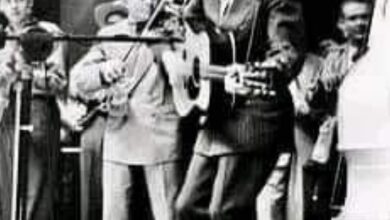Sgt. Barry Sadler’s “Ballad Of The Green Berets” Provides A Powerful And Patriotic Homage
In 1966, Staff Sergeant Barry Sadler achieved notable recognition in American music and culture with the launch of “The Ballad of the Green Berets.” At a time when the United States was embroiled in the Vietnam War, this song emerged as a patriotic anthem, firmly resonating with a nation dealing with internal conflicts. The lyrics served as a heartfelt tribute to the bravery and dedication of the Army Special Forces, better known as the Green Berets. Sadler, who had firsthand experience as a medic in Vietnam, where he faced peril and injury, brought an authenticity and depth to the song that struck a chord with both military personnel and civilians alike.
Upon its release, “The Ballad of the Green Berets” rapidly ascended the Billboard Hot 100 charts, reigning at No. 1 for five consecutive weeks. This kind of success was particularly notable during a period filled with musical innovation and competition, as it rivaled the hits of era-defining bands like The Beatles and The Rolling Stones. The unexpected fame catapulted Sadler into the spotlight, making him a familiar face across various television shows, including the renowned Ed Sullivan Show. This exposure allowed him to communicate his poignant message to wider audiences, further solidifying his status as a cultural icon.
However, the triumph of “The Ballad of the Green Berets” formed a challenging backdrop for Sadler’s subsequent musical endeavors. Despite releasing additional songs, none achieved comparable success, leading him to confront the harsh realities of fleeting fame. In response to these setbacks, Sadler explored diverse career paths, including acting and business, though none brought the fulfillment or recognition he sought. This period of struggle reflected the difficulties he faced transitioning from a celebrated musician back to a more ordinary life, highlighting the additional pressures placed upon individuals thrust into the limelight.
In the late 1970s, Sadler pivoted his creative energy towards literature, launching a series of novels featuring the character of Casca Rufio Longinus—a Roman soldier cursed to wander the ages. While the series did not garner widespread acclaim, it attracted a dedicated fanbase. Through these stories, Sadler continued to engage with themes that permeated his music: heroism, sacrifice, and the exploration of the human condition. His ability to weave narratives that celebrated valor and personal struggle resonated with readers, just as his songs had with listeners.
Yet, alongside his creative pursuits, Sadler’s personal life became increasingly tumultuous. In 1978, he was involved in a tragic incident that led to the death of songwriter Lee Emerson Bellamy, for which he was convicted of voluntary manslaughter. The consequences of this event irrevocably changed the trajectory of Sadler’s life, ushering in a series of challenges that included legal struggles and public scrutiny, as he attempted to navigate the aftermath of his actions. This episode marked a dramatic departure from the celebrated image he had cultivated as an artist.
Seeking a refuge from the whirlwind of his troubles, Sadler emigrated to Guatemala in the 1980s, where he remained actively engaged in writing while also returning to his roots in medicine to offer assistance to locals affected by civil conflict. This period of his life represented a complex interplay between seeking redemption and continuing to contribute positively to the world, showcasing his resilience and commitment to helping others even in the face of adversity.
However, tragedy struck again in 1988 when Sadler became the victim of a violent crime during a robbery attempt in Guatemala, resulting in significant injuries, including a gunshot wound to the head. The aftermath left him with severe medical complications that led to a state of quadriplegia and profoundly affected his quality of life. This shift highlighted the fragility of existence and the unpredictable nature of personal circumstances, helping to frame Sadler’s later years in a context of struggle and survival.
Barry Sadler passed away in 1989, leaving behind a complex legacy. His iconic song, “The Ballad of the Green Berets,” remains a profound expression of tribute, often played at military memorials and events, reinforcing its status as an enduring piece of American musical history. The song serves not only as a celebration of military service but as a poignant reminder of the sacrifices made by countless individuals during the Vietnam War era. It encapsulates the dualities of pride and pain that come with war, acting as a conduit for both reflection and remembrance.
Despite the shadows cast by his later controversies, Sadler’s contributions to music and literature cannot be overlooked. His storytelling ability enabled him to connect with audiences on a deeply emotional level, reflecting the struggles of service members and the sacrifices they make for their country. The complexities of his life—marked by triumph, tragedy, and redemption—invite deeper discussions about the legacies left by veterans and the societal perceptions of their service, both celebrated and scrutinized.
Moreover, Sadler’s journey illustrates the deep ties between creativity and personal experience, showcasing how artists often draw on their lives’ complexities to convey powerful narratives. “The Ballad of the Green Berets” endures not just as a piece of music but as a significant cultural artifact reflecting a nation wrestling with its identity during a time of upheaval. Sadler’s life story, intertwined with his artistic output, emphasizes the importance of honoring and understanding the experiences of veterans, fostering greater empathy and appreciation for their sacrifices.
Thus, Barry Sadler’s legacy continues to spark relevant discussions surrounding the narratives of war, heroism, and the human experience. His work invites ongoing contemplation regarding how society chooses to remember and honor the contributions of those who serve, reinforcing the notion that art, at its best, serves as a bridge between the past and present, shaping collective memories and identities even through trials and tribulations.





